You are here: Home > Projects > World War 1 > The Role of Uniformed Youth Organisations on the Home Front in our Area
The Role of Uniformed Youth Organisations on the Home Front in our Area
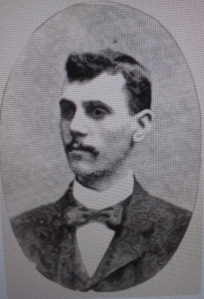 Edward Hope Hawthorne was a teacher at Scarcroft School in the years before the First World War, who became the first Headmaster of the special Scout School in York. This was set up in two classrooms at the Brook Street School in The Groves in September 1914.
Edward Hope Hawthorne was a teacher at Scarcroft School in the years before the First World War, who became the first Headmaster of the special Scout School in York. This was set up in two classrooms at the Brook Street School in The Groves in September 1914.
Left: Edward Hawthorne, teacher at Scarcroft School
The aim of the school was to provide assistance to the military authorities in the city, while also educating the boys in appropriate practical matters, such as map reading and field surveying. The school seems to have been the brainchild of the Acting Chief Scoutmaster, Cecil Molyneaux, who led the St Paul’s Boy Scout Troop (now the 1st York Poppleton) founded in 1909, the first in York. He taught at the school alongside Edward Hawthorne. Both men enlisted in 1915 and both died as a result.
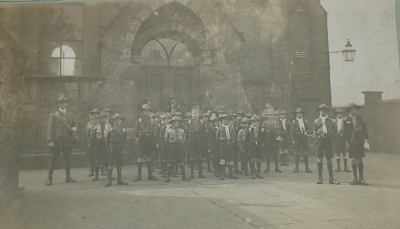
Right: Scout School at Brook St, The Groves 1914
The Scout School continued throughout the First World War, moving several times, finishing at the newly built Knavesmire School. Hawthorne is commemorated on the WW1 memorial at Scarcroft School.
The Scout movement played an important role on the Home Front in our area during the Great War, scouts often taking on the duties of men away fighting, for example acting as coastguards at Scarborough and Whitby. We’re keen to explore this aspect further and also want to research other youth organisations in South Bank at this time, including both girls and boys. We’ll be looking at local newspapers, school and parish magazines, archives at York Explore and other online resources.
Girl Guides
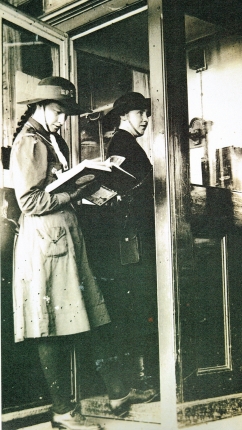 Although there was no company of Girl Guides at Scarcroft School, units had been opened within the community. In 1913 a unit was set up, the 4a York English Martyrs, at St Mary’s Convent. Later the 5th and 5a York companies of Girl Guides were opened at St Clements Church.
Although there was no company of Girl Guides at Scarcroft School, units had been opened within the community. In 1913 a unit was set up, the 4a York English Martyrs, at St Mary’s Convent. Later the 5th and 5a York companies of Girl Guides were opened at St Clements Church.
At first the Girl Guides encountered some hostility. Many people thought it was unseemly for young women to be traipsing around the countryside dressed in outlandish clothes and doing boyish activities. But skills which they had been practising proved to be very useful during the dark days of World War 1. A war badge was introduced which they could achieve by service in the local hospitals or by doing activities such as knitting socks, mittens and other clothing articles for men at the front.
A guide and her captain receiving messages
Guide halls and the church rooms were turned into first aid and dressing stations in readiness for enemy raids or invasion. Many volunteered as scullery maids and laundry workers in the local hospitals. The Guide companies collected waste paper as part of the community contribution towards the war effort and helped with the harvest on the local farms. Many acted as messengers for the army and government offices. All these skills were extremely valuable to the war effort and were encouraged by Lord Baden Powell and his sister Agnes, founder of the Girl Guides.
We're very grateful to Angie Goddard, Regional Archivist, Girlguiding NEE for help with our researches.
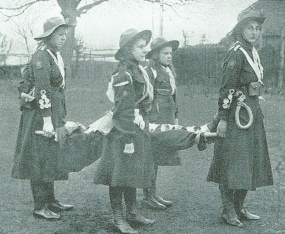
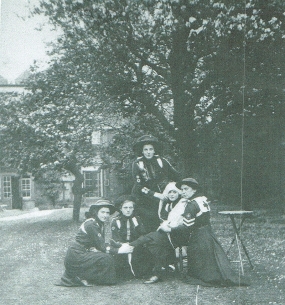 Bringing in the wounded
Bringing in the wounded
If you would be willing to help us with this research, or have any family stories or information on this topic to share, please contact us by email at enquiries@clementshall.org.uk or leave a telephone message on 01904 466086.
First aid practice




 Edward Hope Hawthorne was a teacher at Scarcroft School in the years before the First World War, who became the first Headmaster of the special Scout School in York. This was set up in two classrooms at the Brook Street School in The Groves in September 1914.
Edward Hope Hawthorne was a teacher at Scarcroft School in the years before the First World War, who became the first Headmaster of the special Scout School in York. This was set up in two classrooms at the Brook Street School in The Groves in September 1914.
 Although there was no company of Girl Guides at Scarcroft School, units had been opened within the community. In 1913 a unit was set up, the 4a York English Martyrs, at St Mary’s Convent. Later the 5th and 5a York companies of Girl Guides were opened at St Clements Church.
Although there was no company of Girl Guides at Scarcroft School, units had been opened within the community. In 1913 a unit was set up, the 4a York English Martyrs, at St Mary’s Convent. Later the 5th and 5a York companies of Girl Guides were opened at St Clements Church.
 Bringing in the wounded
Bringing in the wounded